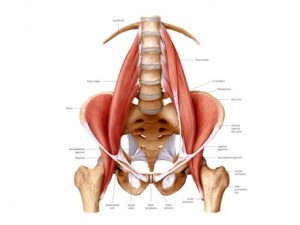Psoas Strain and Back Pain
I had a patient come in a few days ago who got up that morning, bent over to pick up an exercise mat, and was unable to come back up due to excruciating pain in her lower back. I hear this kind of story frequently.
People come in, bewildered, wondering how doing something that they’ve done hundreds of times before, on that particular day, could literally drop them to their knees in pain. How is it that picking up something as light as a fold-up exercise mat could make your back “seize up”?
Clearly, it wasn’t the mat that did it.
The Most Important Muscle in Your Back
To understand what the real culprit is, we need to go over some basic anatomy. Specifically, we need to get intimately acquainted with the psoas muscle (pronounced SO-UHS).
The psoas is a large muscle, deep in the core of your body. It originates from all of the vertebrae and discs (in between the vertebrae) in your lower back. It inserts deep in your groin area, on the inside of your femur, or thigh bone.
It’s a thick muscle. Well developed, it’s about as big around as your lower forearm.
Keep in mind that a muscle’s strength is directly proportional to it’s cross-sectional area. Roughly translated, that means the larger the muscle, the greater it’s ability to generate force.
A muscle with a diameter equal to the size of your forearm is pretty respectable. Most people’s bicep muscle in the upper arm isn’t near that size. This means the psoas has power. Power to move, and power to do damage.
Psoas Muscle
If you take a look at the illustration above, the psoas is the muscle that originates in strands from all of the vertebrae in the lower back, then travels deep through the pelvic opening, inserting on the inside of the femur below the hip joint.
If you’ve ever seen a sailboat mast you’ve probably noticed that the mast doesn’t just stick up out of the boat with no other support. There are usually wires, called “stays”, that run from the mast to the front, back, and sides of the boat to provide stability.
Your spine needs similar help. Your back would not be stable if your spine simply stuck straight up from your pelvis with no assistance from other structures. Your psoas muscles provide a great deal of this support.
Without healthy, strong psoas function, your back just isn’t happy.
In addition, the psoas is one of your primary hip flexors. This means one of it’s main jobs is to bring your knees closer to your chest. Anytime you’re bent over, sitting, doing sit-ups, or performing your best cannonball into the pool, the psoas is potentially in a contracted, or shortened, position.
So What Happened?
This is significant for our exercise-mat-retrieving victim above. The psoas, just like any other muscle, can cramp or spasm.
If you’ve ever had a cramp in your calf or the back of your thigh, you might have noticed that these muscles tend to cramp when the muscle is shortened, not when it’s stretched out. You also probably intuitively stood up to stretch out the muscle to relieve the cramp.
Take a look at the illustration of the psoas again. The psoas runs down the front of your spine. It’s main job is to bend you forward or bring your knees closer to your chest. This means that the only way to really stretch it out well is to bend over backwards.
Most of us don’t do this very well.
So if you happen to be bending over to pick up a pencil, and your psoas decides to go into full blown spasm, you don’t have an easy remedy! It’s exactly like having a cramp in your calf but not having any way to relieve it.
If you can imagine this, you now know why a psoas spasm can be so debilitating.
In Practice
In my practice, for anyone with back pain this means the psoas gets a lot of attention. Muscles tend to “shut off” when our bodies are under stress, just like an overloaded circuit in your house (see the article “Why You Have an Athletic Injury” for more on this concept).
I thoroughly test these muscles to make sure my patient is getting the support they need around their core and lower back. On most people, psoas muscles that aren’t working well are usually (painfully) obvious.
For someone who’s had a psoas spasm, the muscle will usually test very weak after a sustained contraction. I then use techniques that help to lengthen and relax the muscle without forcing them into yoga-like moves to bend over backwards.
Adjustments of the lower back and addressing pelvic torque are also key to reducing the propensity for this muscle to seize up again.
As with any muscle cramp, dehydration can be a key factor inducing the psoas to spasm. Many of the stories I hear of people who’s back suddenly “grabbed” on them start out with a description of a long day spent gardening, out in the sun, or working out.
So put yourself in that same scenario, but this time with a new approach. You bend down to pick something up. All of a sudden, a sharp pain hits you in your lower back.
Don’t ask yourself what was different about the way you reached down this time. Ask yourself what is different in you that caused you to not have the muscular support to do something you’ve done hundreds of times.
Is it dehydration? Have you had other lower back “twinges” or discomfort that might have been your body’s way of telling you that everything wasn’t quite perfect? Do you feel “twisted”, with one hip or shoulder higher than the other?
If you can’t clearly answer questions like those and address the problem, get some help to do just that. Your body will thank you, and seemingly innocuous exercise mats will no longer be your nemesis!


